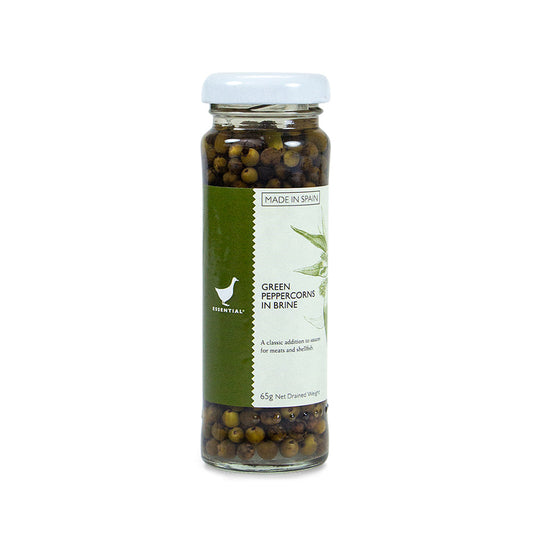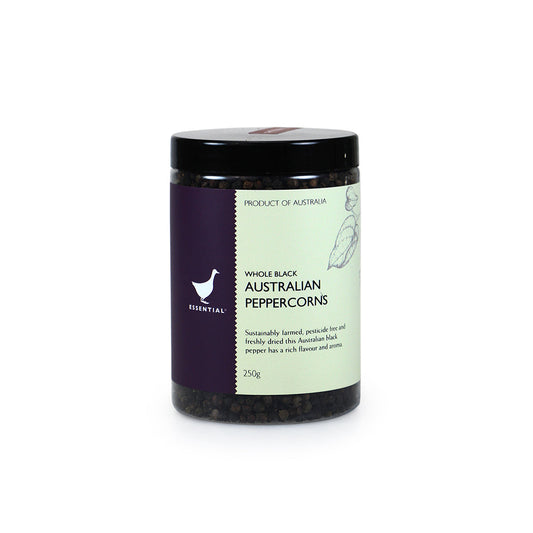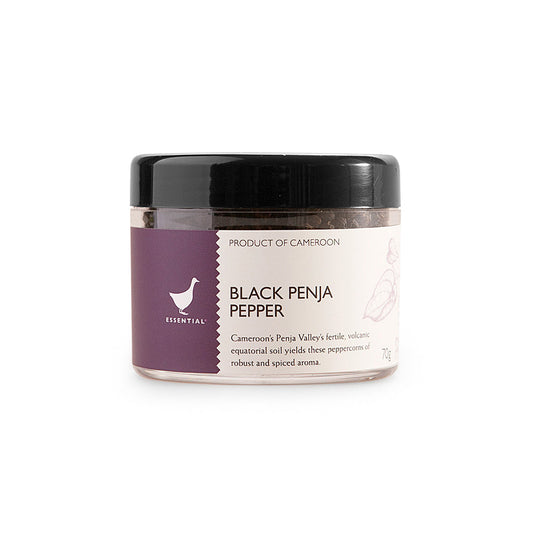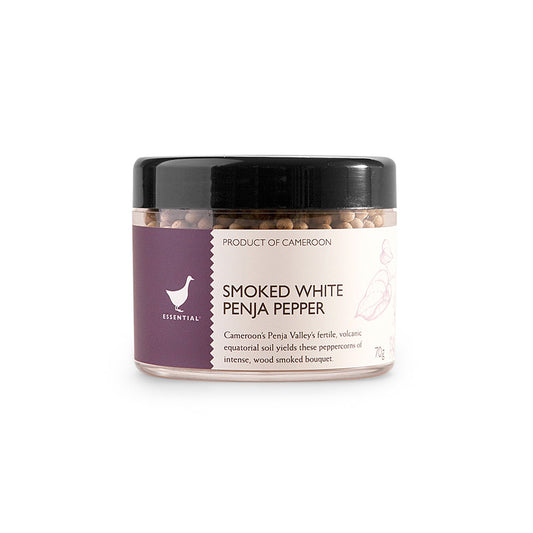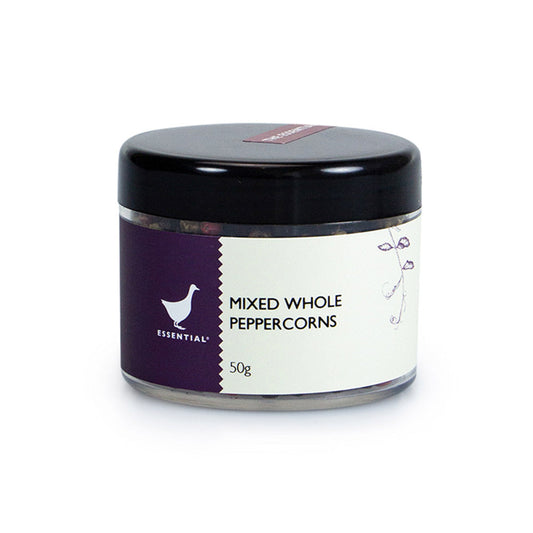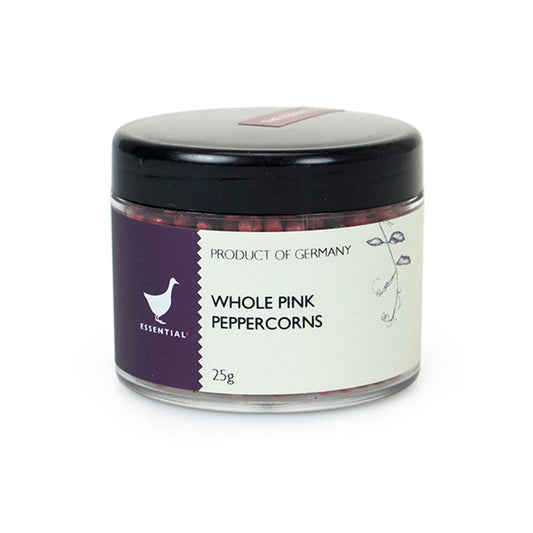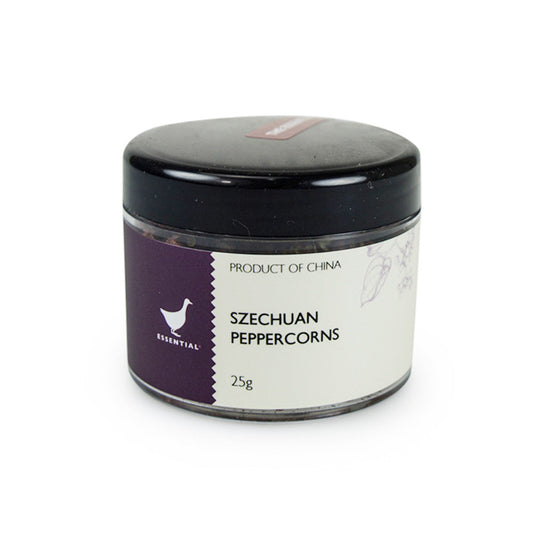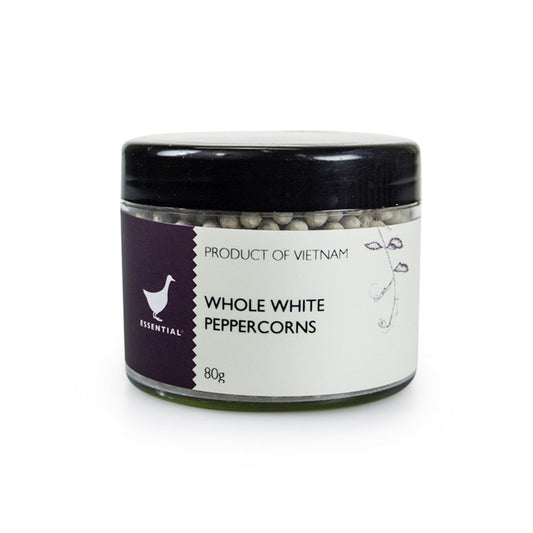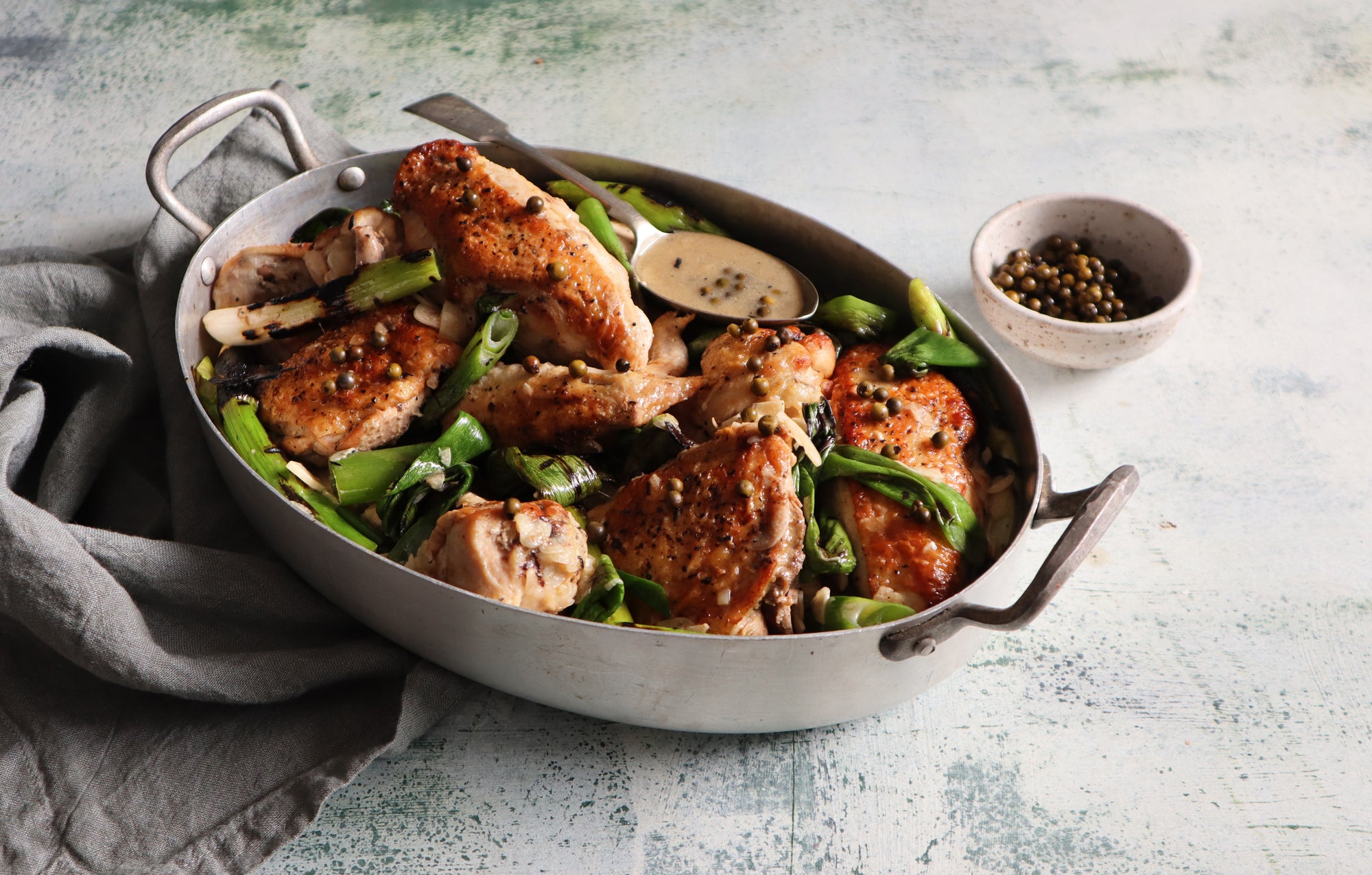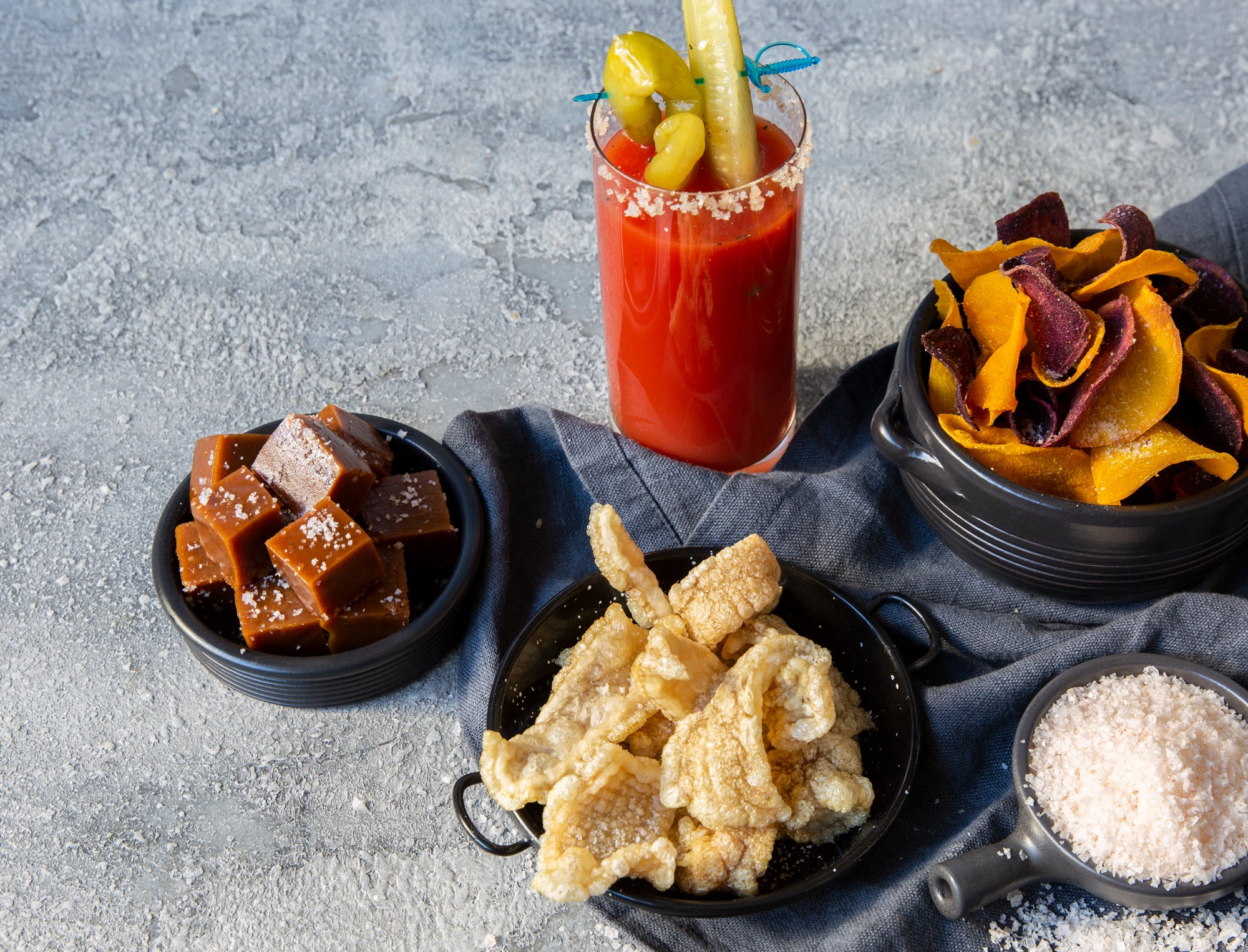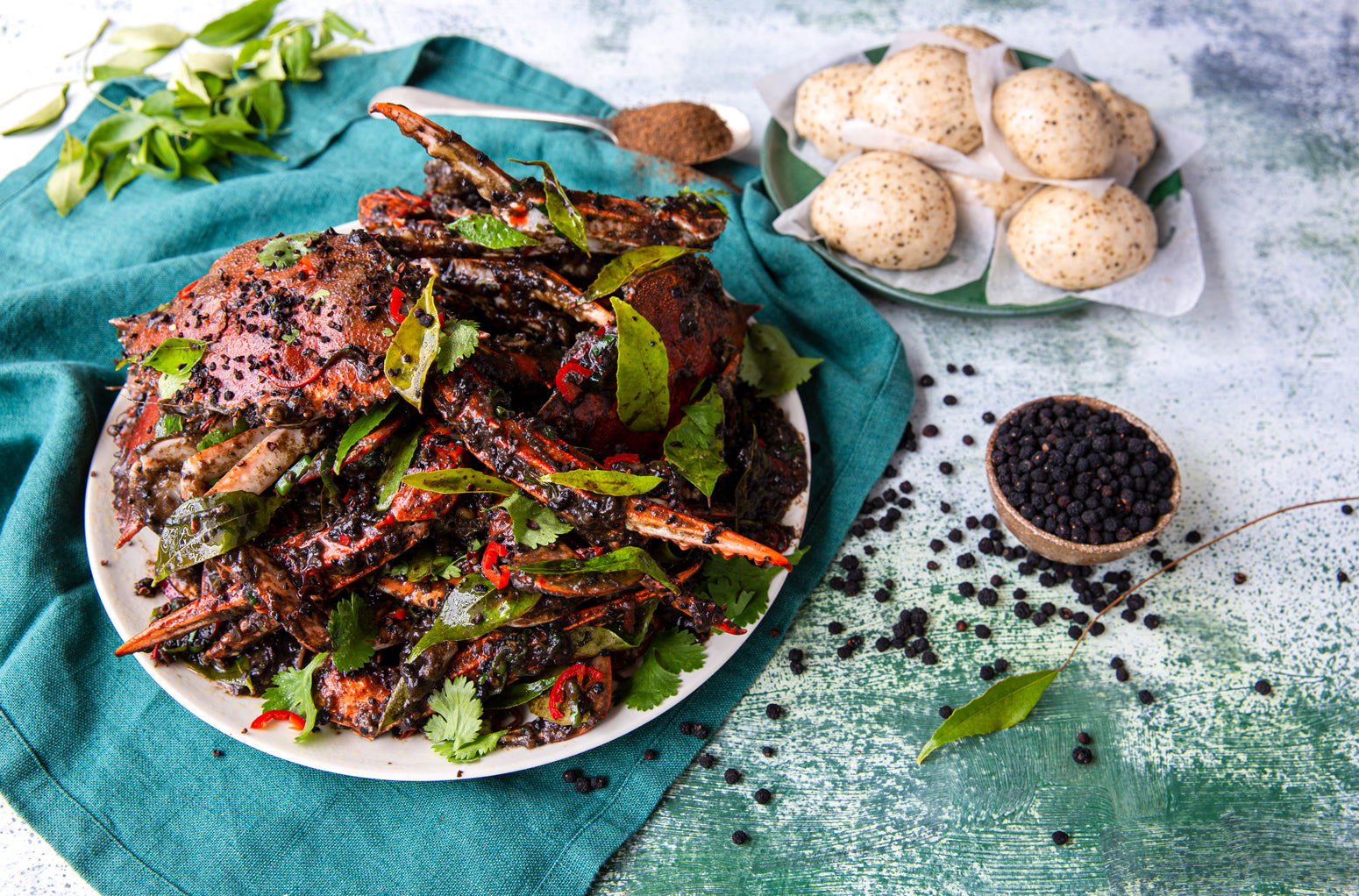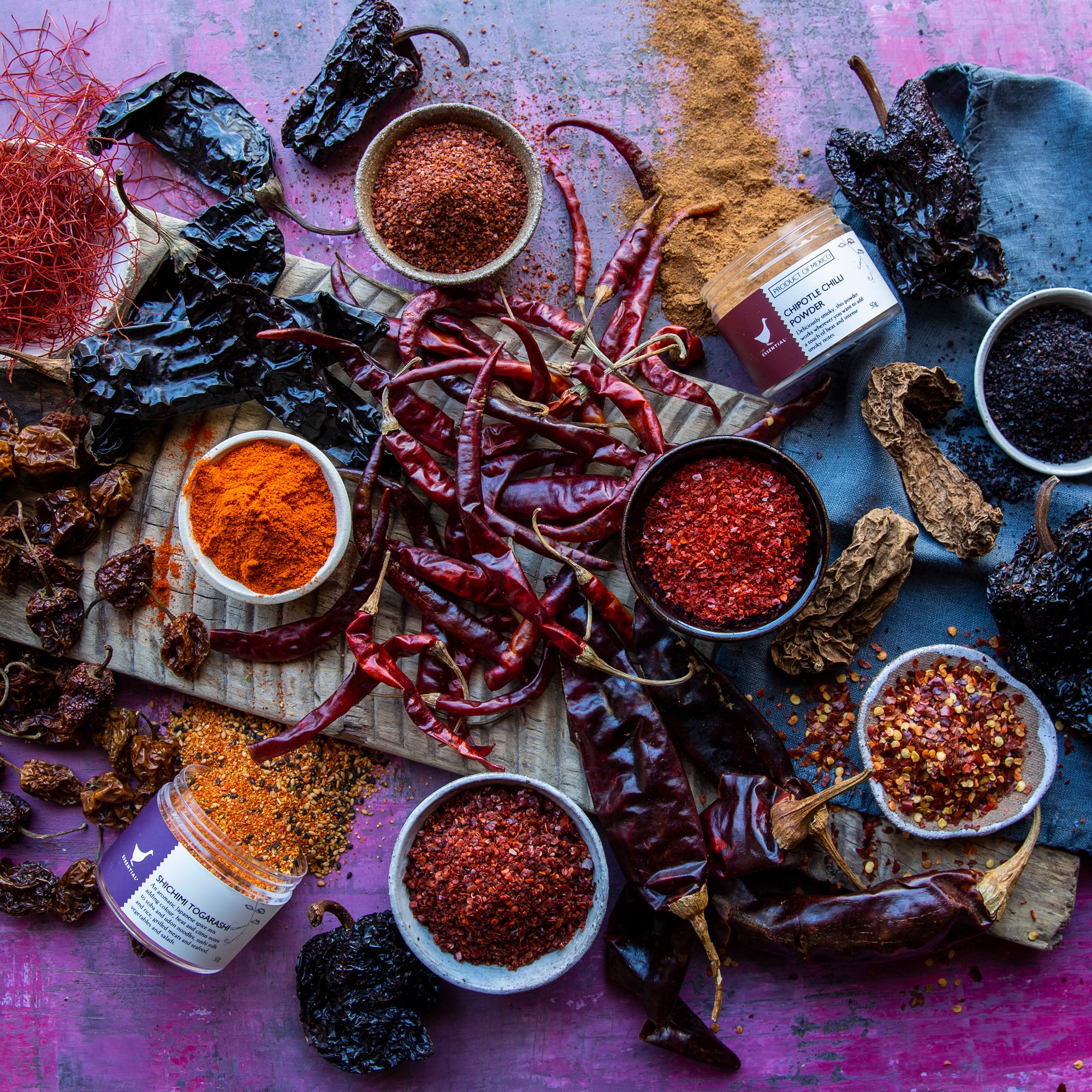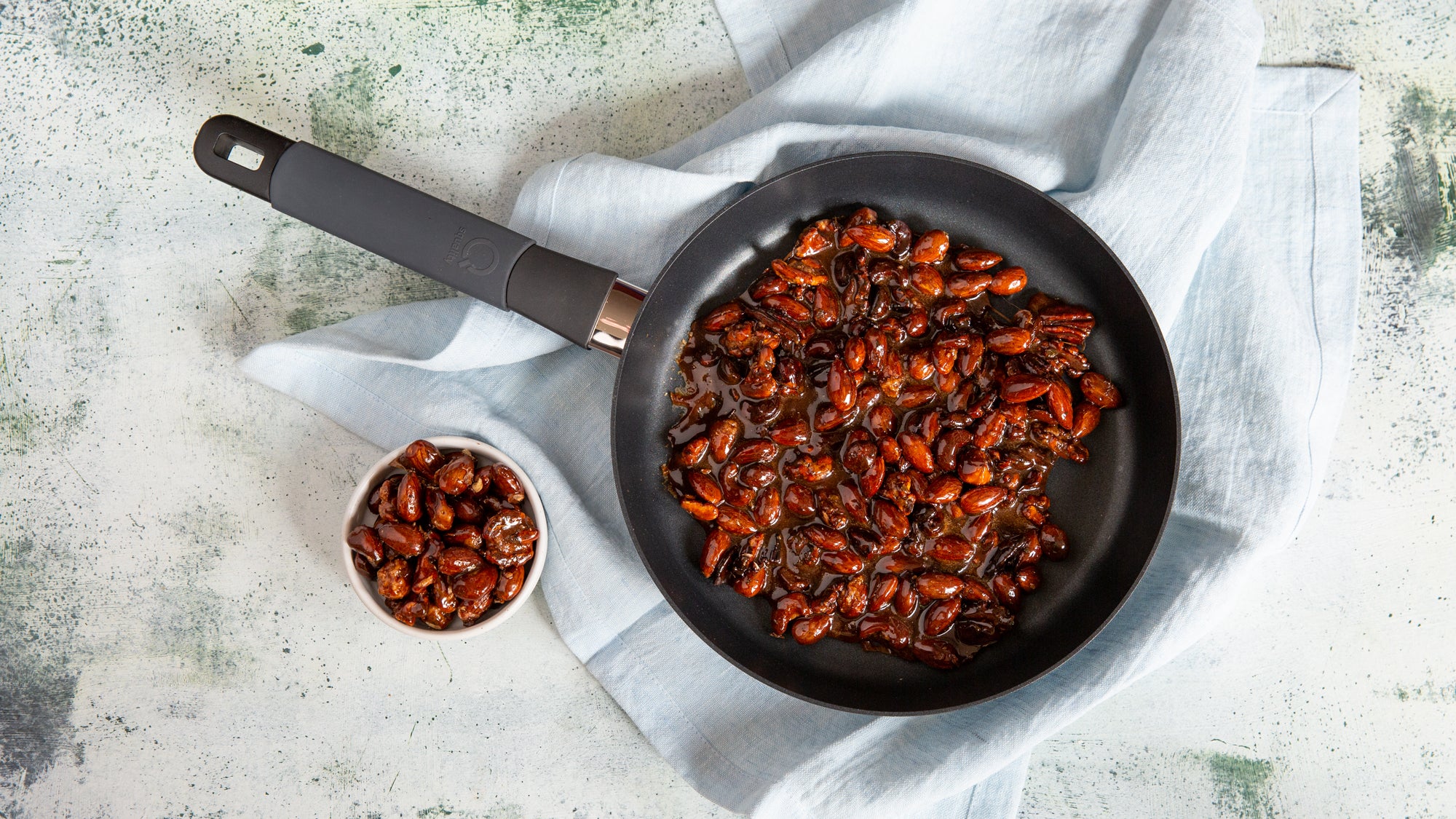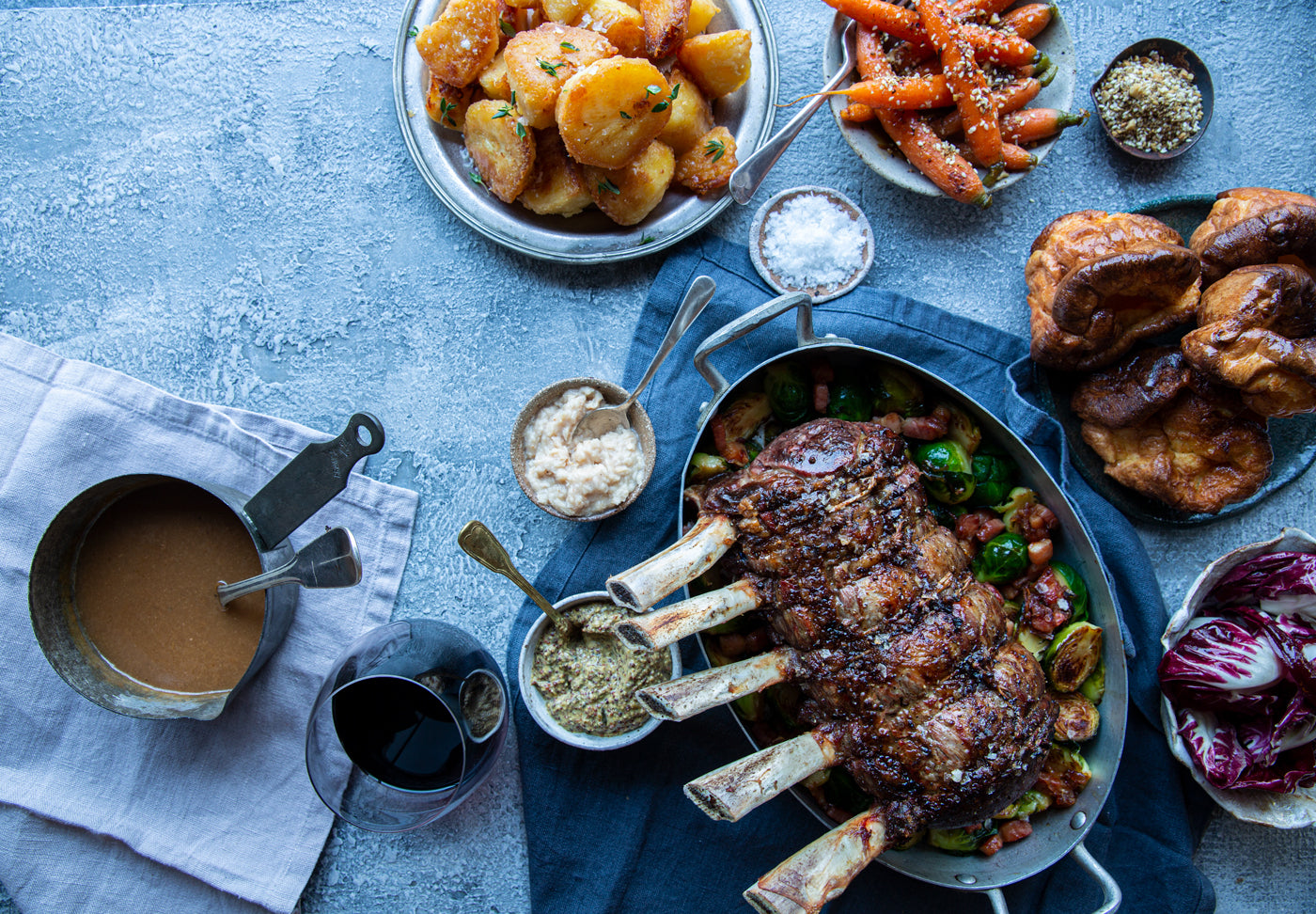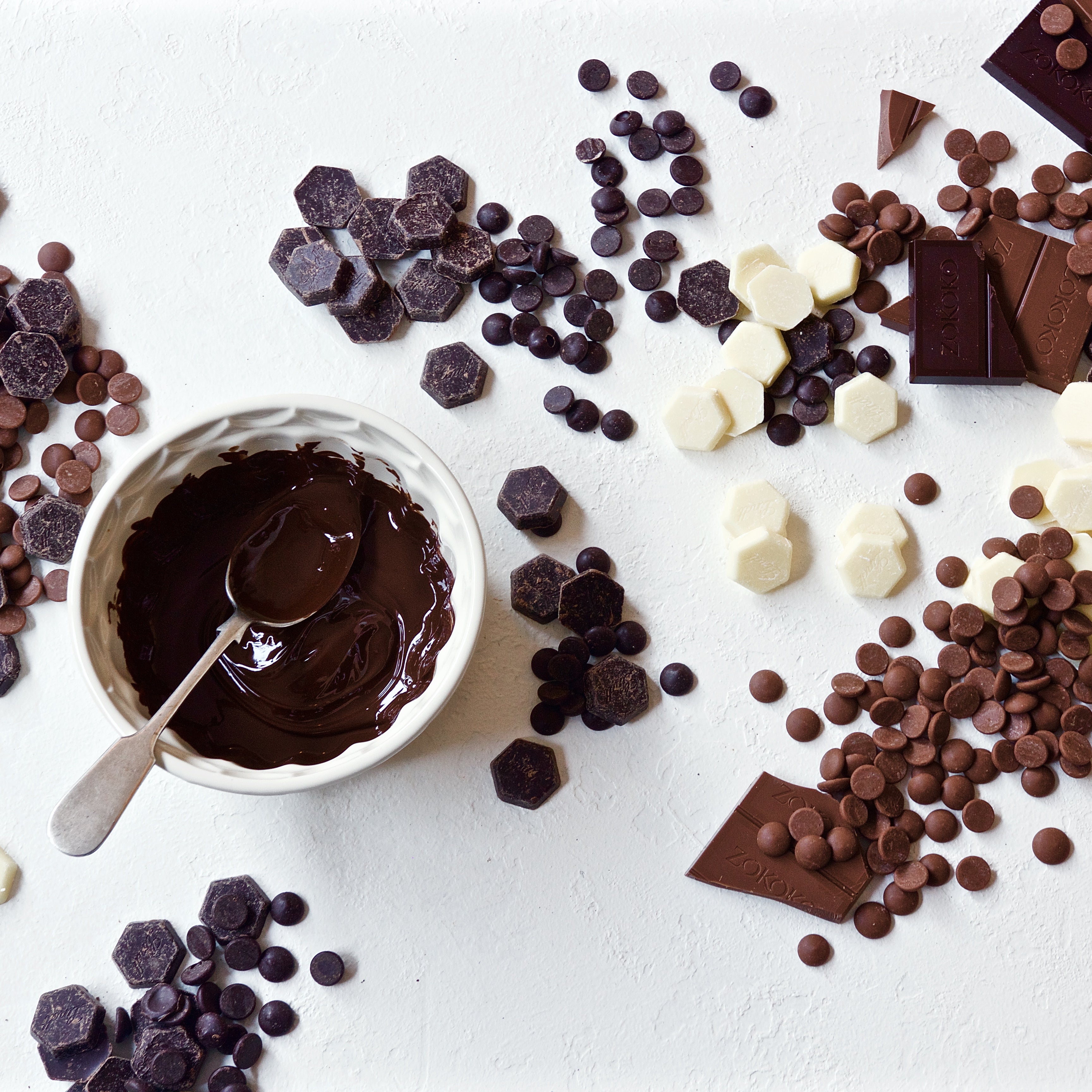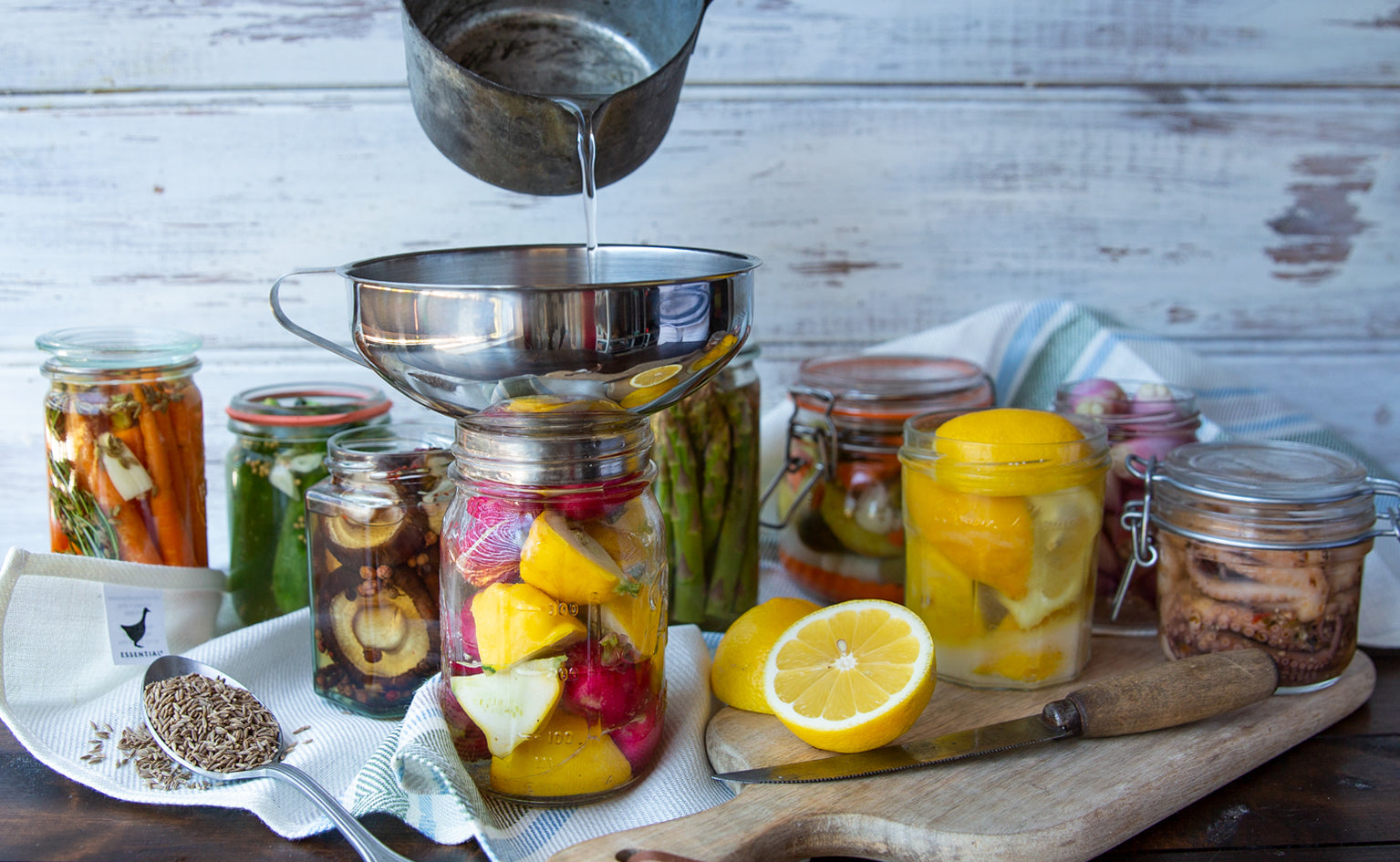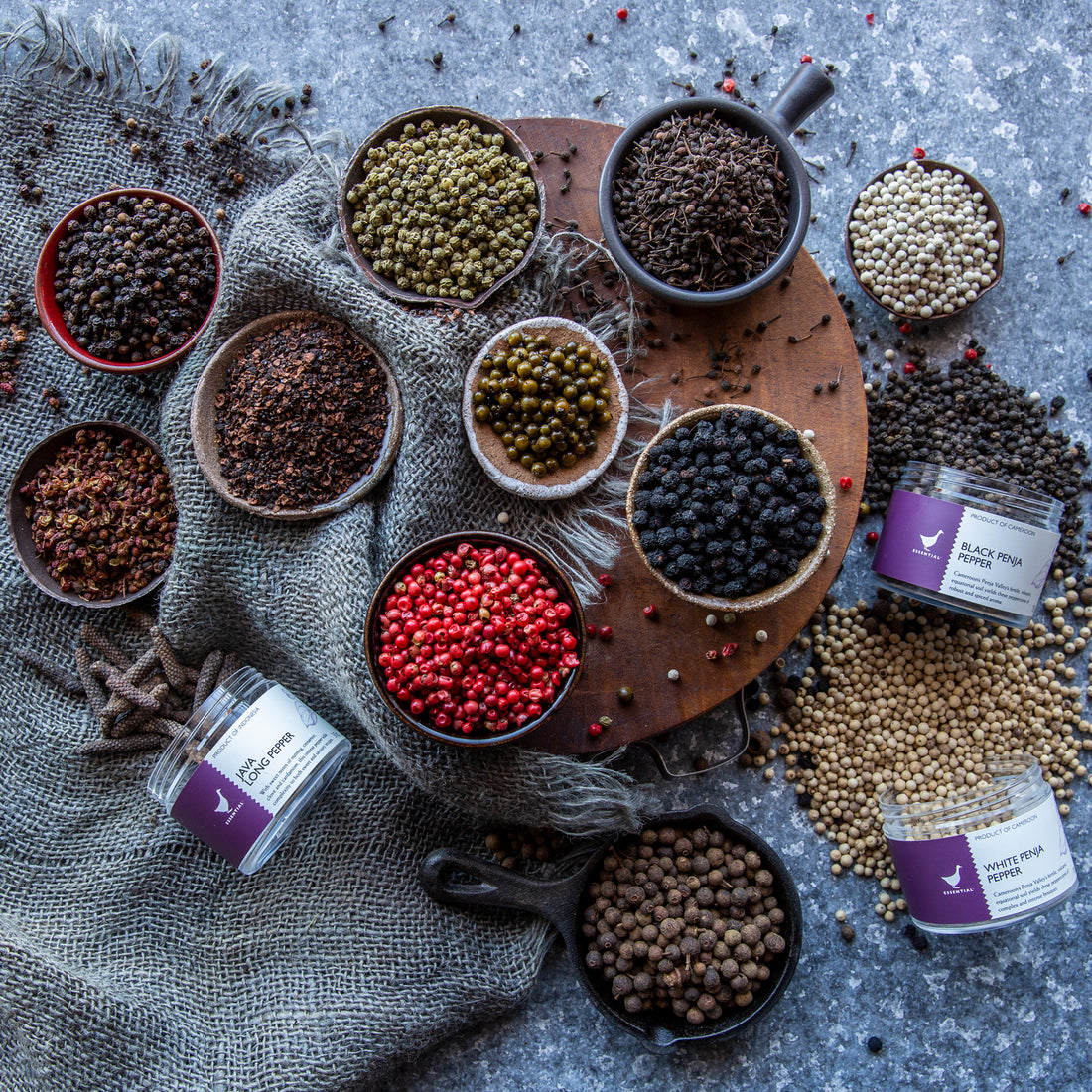
Essential guide to pepper (with a recipe for Steak Au Poivre)
Last updatedThe peppercorn, which is the berry of the piper nigrum vine, holds an important place in the history of food. It’s the most popular spice and is used in kitchens all around the world. Pungent, fruity, earthy, hot, sweet, woody - pepper’s distinct flavours pair well with most savoury food and many sweet dishes too.
The type of pepper you choose can profoundly influence the taste, aroma, and tone of your dishes. At The Essential Ingredient, we proudly stock a wide range of peppers collected from around the world, each variety offering a unique character - from the fragrant kick of black peppercorns to the lemony tingle of Szechuan peppercorns - and understanding the nuances of the different varieties can make all the difference when you next reach for that pepper mill.
Black Pepper
Black pepper, often hailed as the king of spices, reigns supreme in kitchens around the globe. Black peppercorns pack a full-bodied flavour with a pleasant amount of heat that complements a myriad of dishes. Whether freshly ground over a steak or incorporated into tea blends, its bold presence can transform savoury and sweet dishes alike.
At The Essential Ingredient we stock black peppercorns from different countries:
- Our Australian peppercorns are sustainably farmed, pesticide free and freshly dried with a rich and full-bodied flavour and aroma.
- Sri Lankan peppercorns are pungent and spicy with floral and citrus notes.
- Vietnamese peppercorns add a warm aroma and sharp bite to any dish.
Black peppercorns are perfect in Classic Steak Tartare, Hong Kong pepper beef stir fry, or use to spice up a pavlova topped with cream and strawberries.
White Pepper
White pepper is made from the same berries as its black counterpart but undergoes additional processing to remove the outer black husk, revealing a pale inner core. It might come as a surprise, but they’re hotter than black peppercorns and have a unique earthy, musty aroma.
White pepper is commonly used in many Chinese dishes like soups, stir fries and marinades. It adds a slow burning heat while not imparting much colour. It’s a great pepper for seasoning seafood, poultry, and vegetables and is perfect for mashed potatoes, bechamel sauce, and is wonderful in these delicious, celebratory Pearl Meatballs.
Green Pepper
These pepper berries are harvested before they reach full maturity and can be found fresh, dried or preserved in brine or salt. Commonly used in dressings, pickles and sauces, like in this Green Peppercorn Chicken, green peppercorns are bright and zesty with a fresh herbaceous flavour, mild heat and a subtle citrusy undertone.
Green peppercorns in brine may be used for a zingy bursts of flavour and for texture in potato salads and stir fries or on pan fried fish. Use green peppercorns in place of or with black peppercorns in Steak au Poivre (recipe at end of article).
Penja Pepper
Whilst Penja Pepper is also from the piper nigrum vine, it deserves a special mention as it is the first product from Africa to receive Protected Geographical Indication Status (PGI). It is harvested in Cameroon where the soils are volcanic, rich, and fertile, which means that Penja pepper has a high concentration of essential oils and aromas.
- Black Penja peppercorns are hot and tannic and are perfect for roast beef or to finish a root vegetable tart.
- White Penja peppercorns are earthy with menthol notes. Delicious sprinkled over burrata dressed with extra virgin olive oil and balsamic vinegar and fabulous when used to finish pineapple or berry cocktails.
- Our Smoked White Penja peppercorns are smoked over beechwood resulting in complex smoky and herbaceous notes which pair perfectly with chocolate, strawberries and tomatoes. Grind over a decadent chocolate mousse or sprinkle on tomato salads.
Use black, white or smoked Penja pepper (or any one of the other peppers in this guide) to make these deliciously crumbly, cheesy sable biscuits:
Combine 150g flour, 100g cubed salted butter, 120g grated parmesan and 1 tbsp freshly cracked pepper in a food processor and pulse until the mixture starts to come together. Turn out and shape into a 5cm diameter log. Wrap and place in the fridge for at least an hour (longer is better). Preheat oven to 180C and line a baking tray. Remove log from fridge and cut carefully into 5mm discs and place on the baking tray, leaving gaps between each disc. Bake for 15 minutes or until golden.
Java Long Pepper
Java Long Pepper is from the piper retrofactum plant and was the first pepper imported into Europe. It has an elongated shape (hence the name) and is hot and spicy with delicious notes of cinnamon, liquorice and aniseed.
Grate or crack over lamb dishes, tomato sauces and even desserts. Add to risottos, seafood dishes and creamy sauces. Add to red berry jam for delicious spiciness.
Voatisperifery Pepper
At the heart of the Malagasy forests, Voatsiperifery pepper creepers (from the piper borbonense plant) can grow up to 10 metres high. Voatsiperifery peppercorns are a little addictive with their woody, floral notes and a fresh citrus hint.
Very versatile and fantastic in savoury and sweet dishes, this very special pepper is fantastic ground directly onto chocolate mousse or added to the batter of chocolate macarons before cooking.
Use to spice up duck or salmon rillettes or use to coat tuna steaks before searing in a hot pan.
Szechuan Pepper
Unlike traditional peppercorns, Szechuan pepper (also known as Sichuan pepper), comes from the prickly ash tree, which is native to the Szechuan province of China. The prickly ash tree is a member of the citrus family and the hand harvested berries open into a floral shape.
Commonly found in Chinese, Nepali and Tibetan cooking, this unique spice is known for its ability to induce a tingling, numbing sensation on the palate, known as "ma la" in Chinese cuisine. The citrusy characteristics of these berries pairs exceptionally well with pork, duck and chicken, as well as seafood and tofu, and is a great option for spicy stir-fries, aromatic soups, braises and flavoured oil.
Try making Hetty McKinnon’s Everything Oil and use that to dress cold noodles and finish with sesame paste, toasted sesame oil and spring onions.
Pink Pepper
Contrary to their name, pink peppercorns hail from a different botanical family altogether. Harvested from the schinus molle tree (a member of the cashew family), these pretty pink berries have a delicate flavour profile that is sweet, fruity and piney (not unlike juniper berries) with very little heat. Their gentle spiciness and vibrant colour make them a delightful addition to both sweet and savoury dishes like salads, cheeses and desserts.
A scattering of crushed pink peppercorns is fantastic on brie cheese, white chocolate ganache or a stone fruit tart.
Throw pink peppercorns into foaming brown butter and then add al dente pasta to the pan with a little of the cooking water. Finish with Parmigiano Reggiano to make a delightful pink cacio e pepe.
Native Mountain Pepperberry
These blue-black berries come from a native Australian shrub found in the northern mountainous region on Tasmania. Coveted by professional chefs for its unique fruity aroma, mineral flavour and punchy pepper bite, mountain pepperberry is a hotter and more complex alternative to black peppercorns and can be used for sweet and savoury applications.
Grind and use to season steak, roast vegetables, and eggs, or lightly crush and add to pickling brine and stocks. We’ve made it the star ingredient in this Australian native themed recipe: Pepperberry Crab With Wattleseed Buns.
Mixed Peppercorns
Unsure which peppercorn to buy? Our Mixed Peppercorns combine vibrant green, fruity pink, sharp white and bold black peppercorns. The blend is very versatile and can be used to make a wonderful sauce for roast beef, to coat a pork chop before pan frying or to season salads.
RECIPE: Steak Au Poivre
Ingredients (Serves 2)
- 2 x 300g sirloin or porterhouse steaks
- 100ml brandy
- 200ml beef stock
- 150ml cream
- 3 tbsp (plus more for seasoning steaks) fresh coarsely ground peppercorns - any colour will work or sub with crushed green peppercorns in brine
- Salt to taste
- 2 tbsp neutral oil with a high smoke point like grapeseed or avocado
Allow steaks to come to room temperature. Pat the steaks with paper towel to dry the surface of the meat. Season both sides with salt and a very generous amount of freshly cracked pepper.
Heat oil in a heavy pan on high until smoking. Add steaks and cook for 2 minutes per side (to form a lovely crust) and then sear the fat strip. Remove from the pan and rest on a plate while you make the sauce.
Deglaze pan with the brandy and cook until there is no harsh alcohol smell then add the beef stock. Simmer until reduced to half. Turn heat down to medium and add ground peppercorns and cream. Stir to combine and simmer until the sauce has thickened and coats the back of a spoon. Taste and add salt or more pepper if needed.
Serve immediately over the rested steaks. Green beans and buttery mashed potatoes make perfect sides.

